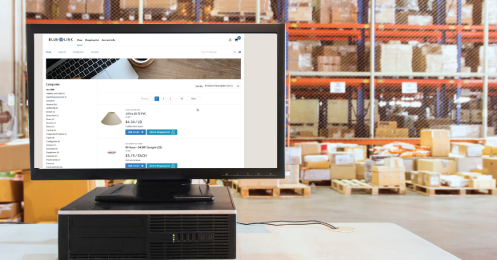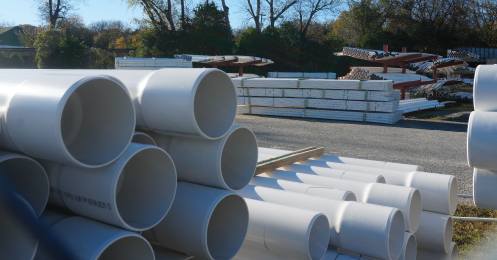If you can't ship and deliver products to your customers in a timely fashion, you're out of the competition...especially in the fast-paced world of eCommerce. Thanks to eCommerce giants like Amazon, customers expect better services and faster shipping times and these offerings aren't slowing down anytime soon – at the end of the first quarter of 2023, it was reported that there were approximately 167 million Amazon Prime users in the United States alone.
While there are some key differences between B2B and B2C eCommerce, your customers still expect you to keep up with the offerings that they are accustomed to with B2C webstores. This is evident as we see more and more B2B eCommerce stores offering B2C functionality such as having high-quality images and videos, online search functionality, personalized recommendations, mobile optimization etc. With the growing number of Amazon Prime members, all customers, whether B2C or B2B have come to expect faster delivery times, flexible shipping options, and cheaper shipping costs. Lucky for B2B businesses such as distributors and wholesalers, this can be achieved with an ERP-integrated Web Store.
B2B eCommerce sales tend to have higher than average dollar value and include fewer one-item orders compared with B2C, which helps to simplify the picking, packing and shipping process for wholesale distributors. However, selling online means increased order volume which leaves no room for an inadequate order fulfillment process. Order fulfillment is a critical element of a B2B eCommerce operation and customers expect that their orders are dispatched quickly and efficiently - this is a key factor in attaining repeat business and ensuring customer satisfaction. So, before diving head first into the exciting world of online selling, integrate your eCommerce webstore with proper ERP software first, to ensure you have a rock-solid process for the picking, packing and especially shipping of product. This will allow you to keep up with the demands of an increased order volume and remain competitive.
What is an ERP Integrated Web Store?
As you already know, an ERP system is a sort of all-in-one business management system. Think of it as the back end. The web store on the other hand is the front end, what the customer sees if they want to place an order themselves. An ERP Integrated Web Store integrates the back end with the front end so information is up to date in real time, such as customer and shipping information.
How does it work?
With ERP software, once an order is placed online, the information automatically generates a sales order in the system, updating quantities available both on the website and in the ERP system and allocating inventory for picking. Once the order is picked and packed, you can easily select the order to ship, enter shipment details, print the documents required to accompany the order, and mark the order as shipped. Once the order is shipped, the ERP system maintains a history of the shipment, the number of boxes shipped, and the items assigned to each box.
Other beneficial shipping functionality to consider in a new ERP system for your integrated web store includes:
- Pack-to-Container
- Courier Integration
- Rate Shopping
- Provide Tracking Information
Pack-to-Container
With pack-to-container functionality, you can see picked orders from multiple sales channels (including eCommerce) that are going to the same ship-to address from the sales order review screen. The pack-to-container screen is used to verify the accuracy of the items picked in relation to the items ordered and to record which products are packed in which containers and which containers make up the entire shipment. Detailed sections in this screen allow you to see how many packing boxes or containers are part of the shipment and gives you the ability to add more as required. You can see which products are packed and which items are remaining to pack into the boxes.
If a user tries to include any product not on the list, the system will generate an error message that the product is not a part of the order thereby preventing the incorrect product from being shipped to the customer. An ERP system that integrates with shipping courier sites [more on this below] populates the overall tracking number for each shipment as well as the sub-tracking number for each shipping container which is populated back into the ERP. This eliminates the time required entering information into multiple systems and the associated keying errors with doing so. Once all items are packed into the boxes and the order is ready to go, the ship button triggers the system to do many different things such as emailing shipping confirmations and printing and/or emailing and posting the sales invoice.
When the order is shipped, Blue Link maintains a history of the shipment, the number of boxes shipped, and the items assigned to each box. Container history information is especially useful in determining which products the customer did not receive in the event of a specific shipping box not arriving at its destination. By tracking shipping containers within your ERP system, the data is accessible to those who need to see it and reports and analysis can be done with the data captured to further enhance efficiency in the process.
Check out the below demo of how the pack-to-container functionality works in Blue Link!
Courier Integration
Courier integration with an ERP system is a challenge that many B2B eCommerce wholesale distribution businesses face. Many require employees to spend countless hours manually extracting orders from their current software or Excel spreadsheets, which they then have to input into courier websites by logging into separate accounts. Then, they must manually enter the shipment and customer information order by order. This type of repetitive, manual process is time-consuming and can be costly when errors are inevitably made.
The key here is to automate this process by integrating courier systems with a true ERP solution. When looking for an ERP system to manage your picking, packing and shipping processes, be sure to choose one that can integrate with large courier companies such as FedEx, Purolator or UPS. With this type of integration, your ERP system will push and pull information from your account on the shipment courier's site to save you from having to enter shipment details twice into two separate software screens. You will be able to access courier screens with links in the actual ERP software and do not need to open or login to courier screens as a separate task. This will allow you to:
- Automatically feed customer shipment information from the ERP system, such as addresses, phone numbers, and emails to courier screens.
- Eliminate the need for employees to manually enter information, thus significantly reducing dispatch times.
- Set up shipment and delivery requirements such as signature needed upon delivery, or insurance required for order over a certain amount.
- Utilize email tracking functions offered by the selected courier services.
Rate Shopping
Blue Link ERP integrates with rate shopping applications to help your business and customers get the best shipping rates on every order. Once orders are packed into boxes and the size and weight of each box has been entered, the ERP system will automatically populate a list of available courier companies as well as the types of services they offer and the rates for each service. Employees then choose an option and the information is used to generate shipping labels and any associated paperwork.
Provide Tracking Information
One of the most common issues for customers is around obtaining tracking information or status updates for their orders. Not only does integrating your ERP with your web store remove the need for employees to manual enter tracking information into the system, it also enables customers to track orders online themselves, reducing order status update inquiries.










